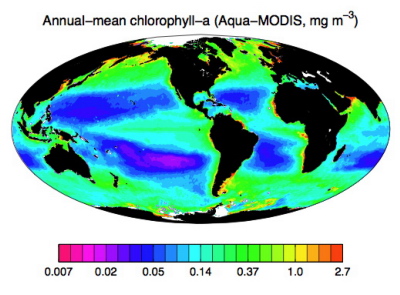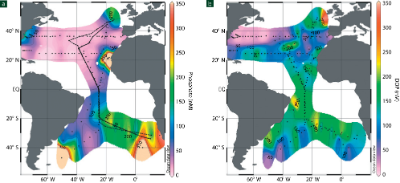Ocean biogeochemistry
|
Figure 1. A false-colour picture of remotely sensed chlorophyll-a (mg m-3) from NASA using Aqua-MODIS. Productive regions of the ocean occur at high latitudes and the tropics (green) where nutrients are brought to the surface via vertical mixing and upwelling. There are also extensive regions with low chlorophyll concentration (blue) over the mid-latitude oceans where the winds force downwelling and inhibit the vertical supply of nutrients from deep waters. |
|
The biogeochemistry of the oceans is modified by climate forcing, as well as in turn affects the long-term evolution of the planet (IPCC, 2007):
|
Work at LiverpoolBiological production over the mid-latitude oceans The mid-latitude oceans are often viewed as ocean deserts due to the low surface concentrations of chlorophyll. However, despite these low concentrations, the extensive area of the subtropical oceans means that they might account for up to half the global biological export of carbon to the deep ocean. We have been investigating how the biological production is sustained in these regions where there are low concentrations of surface nitrate and phosphate in the subtropics of the North and South Atlantic (Figure 2). There are particularly low concentrations of phosphorus in the subtropics of the North Atlantic. Plankton require phosphorus to grow and may instead use the organic form of phosphorus (DOP) (Mather et al., 2008; Roussenov et al., 2006), this adaptation though requires a supply of the trace metal, iron. This strategy of utilizing DOP appears to preferentially occur in the North Atlantic, where there are enhanced inputs of Saharan dust containing iron.
Figure 2. A synthesis plot of (a) phosophorus and (b) dissolved organic phosphorus (DOP) in surface waters over the Atlantic (nmol/kg). There are very low values of phosphorus over the subtropics of the North Atlantic. Any phytoplankton growing there still need a supply of phosphorus, which might be achieved by utilising the dissolved organic form. Further details in Mather et al. (2008).
Presentation in the Marine Sciences Symposium 2008 'Climate change: the science and the impacts - a Liverpool perspective' by Anna Hickman (POL) and Claire Mahaffey (DEOS) on "Marine ecosystem changes: time-series studies in the tropical open ocean and shelf sea environment"
|

